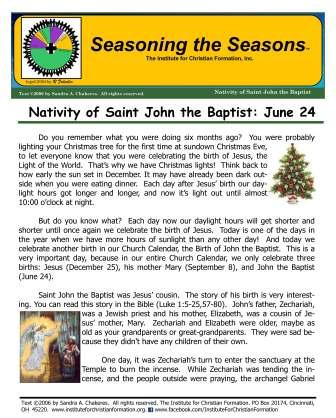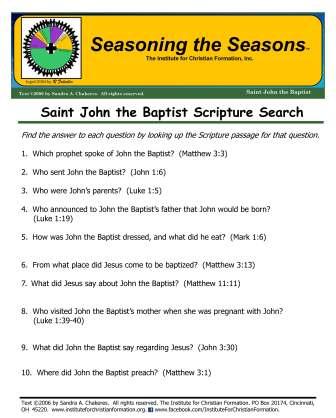The Institute for Christian Formation
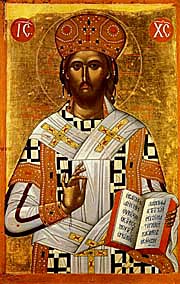
Saint John the Baptist
Feast Days: June 24 (Nativity of Saint John the Baptist);
August 29 (Passion of Saint John the Baptist)
On June 24, we celebrate the Solemnity of the Nativity of Saint John the Baptist. This feast day is significant in that it is one of only three births (or nativities) celebrated during the Roman Catholic liturgical year. Most of our saints’ feast days occur on the day the saint died, therefore their birth into eternal life. Sometimes a saint’s feast is celebrated on another significant date in that person’s life. But we only celebrate three births – Jesus (December 25), Mary (September 8), and John the Baptist. And we do celebrate these as births – not as birthdays. We are not just remembering an event. For example, on June 24 we are celebrating John the Baptist being born today.
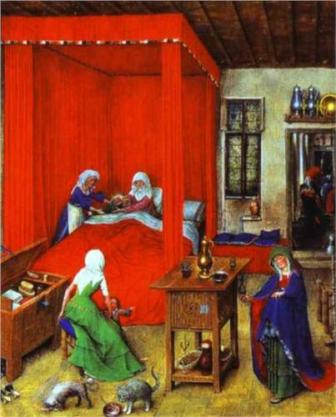
In our Roman Catholic liturgical year, John the Baptist’s Nativity is celebrated as a solemnity. A solemnity is our highest ranking feast day. And it is not only Roman Catholics who celebrate John’s birth. Other Christian denominations such as Anglican/Episcopal, Lutheran, Orthodox, etc., also celebrate the birth of John the Baptist. And this feast day is not a new addition to the Church’s Calendar by any means. The nativity of John the Baptist has been celebrated in both the East and the West from the 4th century!
The liturgical calendar and scripture are wonderful! Read chapter one of Luke’s Gospel. (Luke’s Gospel is the only one of the four gospels which gives us the account of John the Baptist’s birth.) In chapter one of Luke’s Gospel we have the account of the announcement of the birth of John the Baptist, the announcement of the birth of Jesus, the story of the visitation of Mary to Elizabeth, Mary’s canticle (the Magnificat), the birth of John the Baptist, and the canticle of Zechariah (the Benedictus). Wow – that is a lot of pivotal salvation history in one chapter of one book of scripture! In Luke 1:36 the Archangel Gabriel informs Mary that her cousin, Elizabeth, is six months pregnant (with John the Baptist). This announcement is taking place during the account of the Annunciation. We celebrate the Solemnity of the Annunciation of the Lord on March 25. Three months later on June 24 (which would therefore be the completion of Elizabeth’s ninth month of pregnancy) we celebrate the birth of John the Baptist!
The Nativity of Saint John the Baptist: The Midsummer Nativity
The Birth of John the Baptist
Jan van Eyck, 1422
Museo Civico, Turin, Italy
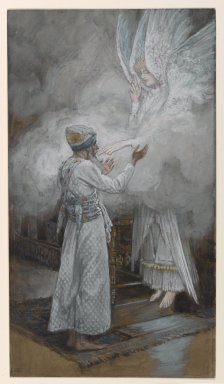
James Tissot (French, 1836-1902). The Vision of Zacharias (Vision de Zacharie), 1886-1894. Opaque watercolor over graphite on gray wove paper. Image: 9 3/8 x 5 1/4 in. (23.8 x 13.3 cm). Brooklyn Museum, Purchased by public subscription, 00.159.13
Here is a brief summary of the birth of John the Baptist in Luke’s Gospel. Luke 1:5-25 tells the story of the Archangel Gabriel’s annunciation to Zechariah (Elizabeth’s husband and John the Baptist’s father) as he was executing his priestly service burning incense in the sanctuary. Elizabeth and Zechariah were elderly, past child-bearing age, and were childless. They had prayed and prayed to conceive. Gabriel announced to Zechariah that his prayer had been heard and that Zechariah’s wife, Elizabeth, who was barren and aged, would give birth to a son named John. But Zechariah was incredulous and questioned Gabriel. Because of this initial doubt, Zechariah was rendered mute until this prophecy was fulfilled. After Zechariah’s priestly service ended and he returned home, Elizabeth conceived.
In Luke 1:57-66 we hear the story of the birth and naming of John the Baptist. Elizabeth, who was aged and had been considered barren, gave birth to her son. Her neighbors and relatives all rejoiced with her. It was the Jewish custom to circumcise and name a male child when he was eight days old.
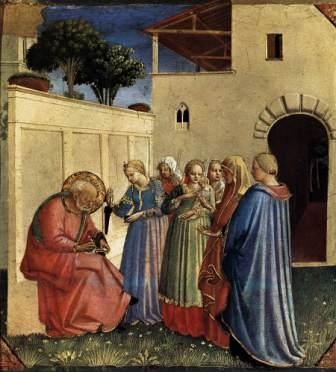
The Naming of John the Baptist
Fra Angelico, 1434-35
Tempera on panel, Museo del Prado, Madrid
So everyone gathered with Elizabeth and Zechariah for this celebration. Now if you recall, Zechariah had been in priestly service in the sanctuary when the Archangel Gabriel appeared to him to announce that Elizabeth would conceive and bear a son named John. But Zechariah had at first doubted how this could be, and because of this doubt, he was rendered mute. So from that moment, Zechariah did not speak. At the celebration for the circumcision for Elizabeth and Zechariah’s son, everyone assumed that the infant would be named Zechariah after his father. But Elizabeth corrected them, stating that the baby was to be named John. Now, the friends and relatives gathered there were confused, as no one in the family was named John. So they asked Zechariah,
who was still mute, what the child was to be named. Zechariah took a tablet and wrote down that his son was named John. And it was at this point that Zechariah was once again able to speak.
Luke 1:67-79 presents us with the words Zechariah prophesied at this time – his beautiful hymn, or canticle, praising God. This Canticle of Zechariah, sometimes called the “Benedictus” because it begins with the words “Blessed be the Lord,” is the canticle sung every morning around the world in the Liturgy of the Hours when Christians pray Lauds, or Morning Prayer. You can find out more about “Lauds” here. On October 1, 2003, Pope John Paul II gave a homily based on Zechariah’s Canticle. It offers us a good reflection, and you can access it here. You might also enjoy a Chamber Music rendering of the Benedictus below.

Saint John the Baptist
Andrei Rublev, 1408
Tretyakov Gallery
Moscow, Russia
The first chapter of Luke’s Gospel concludes with Luke 1:80 which tells us that John the Baptist grew and became strong in spirit and went into the desert where he remained until his public life in Israel.
John the Baptist is an interesting Biblical character. As a prophet preparing the way for Jesus, he acts as a bridge, as it were, between the Hebrew Scriptures and the Christian Scriptures. John can also be viewed as an eccentric character, as he is described in other Scripture passages as wearing clothes made of camel’s hair, with a leather belt around his waist. He wears sandals, and his diet consists of locusts and honey. Children, especially, love these details about John the Baptist. Let children create their own artistic depiction of the Baptist. Loyola Press, as part of their Intergenerational Advent Event, has materials for a John the Baptist activity center, which includes a script for a simple play about John the Baptist, a simple John the Baptist song for young children, a John the Baptist coloring page, as well as a recipe for “grasshopper” (think locust!) cookies. You can access these pages at the Loyola Press web site here. (The song, cookie recipe, and coloring page are all on the Family Handout.)
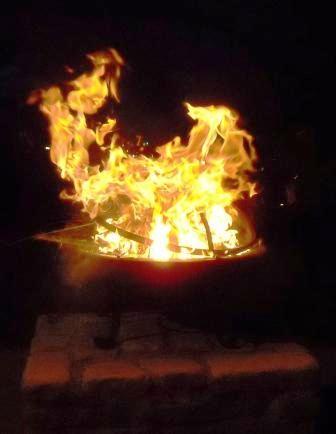
The Nativity of John the Baptist is celebrated June 24, almost exactly six months before we celebrate the Nativity of the Lord on December 25. In John 3:30, John the Baptist, speaking about Jesus, says, "He must increase; I must decrease." We celebrate the Nativity of John at the time of the summer solstice in the northern hemisphere. His birth is celebrated at a time of year when daylight hours are at a peak. Following the celebration of John's birth, daylight hours get less and less each day, until the winter solstice, when we celebrate the Birth of the Lord. Then our daylight hours increase each day - Christ the Light has come into the world! Saint Augustine, centuries ago, made this connection between John 3:30 and what was happening in our natural world with the summer solstice!
The Solemnity of Saint John the Baptist is sometimes called the Midsummer Nativity. And being a solemnity, it has a vigil on June 23, which is sometimes referred to as Midsummer’s Eve. The Midsummer Nativity and its vigil, Midsummer’s Eve, have been celebrated around the world for centuries and centuries. One predominant way of celebrating is with a bonfire. We keep the longest day of the year with raging all night bonfires, keeping even the nighttime bright! And John being the Baptist, water is also featured in many celebrations.
Find out more about some of the many traditions around the world celebrating John’s birth. Below are a few links with interesting information:
•In the Basque region, bonfires are prevalent.
•In Canada, this feast day is a major celebration, and is even the National Holiday in Quebec. Religious celebrations have segued into patriotic and political celebrations, as well.
•Ireland celebrates Midsummer’s Eve with bonfires, and there was also a tradition of a parade of tradesman on Saint John’s Day. Learn more here and here.
•John the Baptist is the patron saint of Florence, Italy, where this feast day is celebrated on a very grand scale. There are parades, a soccer game, and a procession from the Duomo to the entrance of the Baptistry. Read more about this celebration here. Here is a link to information for the 2020 San Giovanni Battista Festival in Florence, Italy, which will be mostly virtual this year due to the pandemic. And this site offers some information on traditional foods served in Italy on this feast day.
•Lithuanian tradition also focuses on fire, sun, and water. There were also traditions of wreaths (connected with marriage) and a tradition of jumping over the fire. Since Jack is a nickname for John, could this tradition be connected to the nursery rhyme, “Jack be nimble, Jack be quick, Jack jump over the candlestick”?
•Fire, water, wreaths, and fireworks are also prevalent in Polish celebrations of the Midsummer Nativity. An interesting note here is that in 2006 Poland even issued a St. John’s Night Coin!
Click on the image above to download our ICF "Story Time for Saints and Seasons" story about the Nativity of John the Baptist.
Click on the image above to download our ICF Saint John the Baptist Scripture Search activity page.
Celebrate the Nativity of John the Baptist this year in your parish community, neighborhood, or in your own back yard! Go to Mass. Pray Morning Prayer with its beautiful Canticle of Zechariah. Build a bonfire and roast marshmallows and other foods. Have a water balloon toss. Run under a sprinkler. Make grasshopper cookies, or even eat some “gummy worms!” Enjoy foods made with honey. Share the story of John’s birth with children. (Download our ICF children’s story about the Nativity of Saint John the Baptist, above.) Host a John the Baptist Scripture search. (Download our ICF John the Baptist Scripture search, above.) Make a wreath. However you celebrate, have a very blessed Midsummer’s Eve and Midsummer Nativity!
